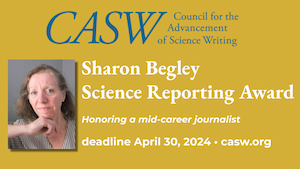By Jessica Orwig
Each February, NASW hosts an internship fair at the annual meeting of the American Association for the Advancement of Science (AAAS). And each year, editors and science communicators from esteemed media outlets take part to assess the next batch of bright-eyed students who might one day work beside them.
As an aspiring science writer, I attended both the 2011 (Washington, D.C.) and 2012 (Vancouver, Canada) internship fairs. Each was nothing short of an adrenaline rush mixed with feelings of anticipation, excitement, and intimidation.
Here’s what I know now that I wished I knew then.
The NASW Internship Fair is similar to speed dating. Students progress around a hotel room receiving five minutes at a time of an editor’s or writer’s undivided attention. Make a good impression and it can lead to a follow-up interview shortly after the conclusion of the fair. Other organizations will encourage you to go through channels and submit a formal application before considering you for an internship. Either way, the internship fair is a great opportunity to meet and build connections with some of the nation’s leading science communicators.
The number and mix of science institutions and media outlets will vary depending on which city the AAAS meeting is held. For example, Washington, D.C., being one of the country’s science writing capitals, attracted more than 30 recruiters in 2011. In contrast, half that number of organizations participated in the Vancouver Internship Fair. The roster for 2014 includes: Nature, Science News, Scientific American, Chemical & Engineering News, Reuters Health, and Fermilab.
In 2011, when I walked into the warmly lit Congressional Room, in the Renaissance Hotel, in downtown Washington, I had no idea what to expect and was, frankly, intimidated at the prospect of speaking with such talented, successful individuals.
The internship fair kicks off with a short introduction by each organization represented: who they are and what their internship program entails. I frantically jotted notes, prioritized the organizations I thought would be the best match, and signed up for a coveted time slot. Due to time constraints, you only get a shot at meeting with four to six organizations. Each editor or writer handles the exchange differently. Some will do most of the talking about their internship program. Others will ask questions; more like an interview. And still others will sit back and listen to your spiel about why you’re the perfect fit.
Yes, the pressure is on. And, five minutes flies fastest when you’re the one doing most of the talking. This makes it imperative that you hone and practice your personal pitch beforehand. Condense it to three minutes and leave the last two minutes for discussion and questions. Have your resume and business cards ready to slide across the table. [I recommend bringing about 50 copies of each not only for the internship fair but for chance encounters with other potential employers during the duration of the AAAS meeting.]
Don’t be surprised if an editor asks for a story pitch. This can either lead to an incredibly productive discussion or a lingering, awkward silence as the minutes rapidly evaporate. In my case, a story I pitched to New Scientist in 2012 led to an hour-long interview the following day for an internship slot. Although I was not chosen for that opportunity, the experience nonetheless proved to be invaluable as the interview questions prepared me for subsequent interviews which ultimately led to four paid science-writing internships over the past two years: American Geophysical Union (Washington), Fermi National Accelerator Laboratory (Batavia, Ill.), International Centre for Theoretical Physics (Trieste, Italy), and American Physical Society (College Park, Md.).
The NASW Internship Fair is an opportunity that could launch your science-writing career. So, prepare, prepare, prepare.
In addition to attention to your personal pitch, story pitches, resume, and business cards, it’s also important to dress professionally. Business casual is the unspoken dress code, although I (as well as others) favor business suits. Suits are merely a personal preference since they make me feel confident, and that is what matters.
Be confident in yourself and your capabilities, and recognize that the editors and science communicators seated across from you are sincerely interested in what you have to say.
Jessica Orwig, a graduate student in Texas A&M University’s Science and Technology Journalism Program, recently completed an internship at the International Centre for Theoretical Physics, in Italy.
2014 NASW Internship Fair at AAAS
The next NASW Internship Fair will take place on Saturday, Feb. 15, during the 2014 AAAS meeting, in Chicago.
Internship fair attendance is limited to current students or those who have graduated within the past 12 months.
All attendees are required to be current NASW members.
NOTE: Because the internship fair takes place at the AAAS annual meeting, students must register with the AAAS newsroom.
Internship fair sign up takes place on site on the day of the event.
Come prepared. Bring proof of NASW membership, copies of your resume, a list of references, and clips to share with recruiters.
For more information, contact fair coordinator Jenny Cutraro or see this announcement.

.png)

